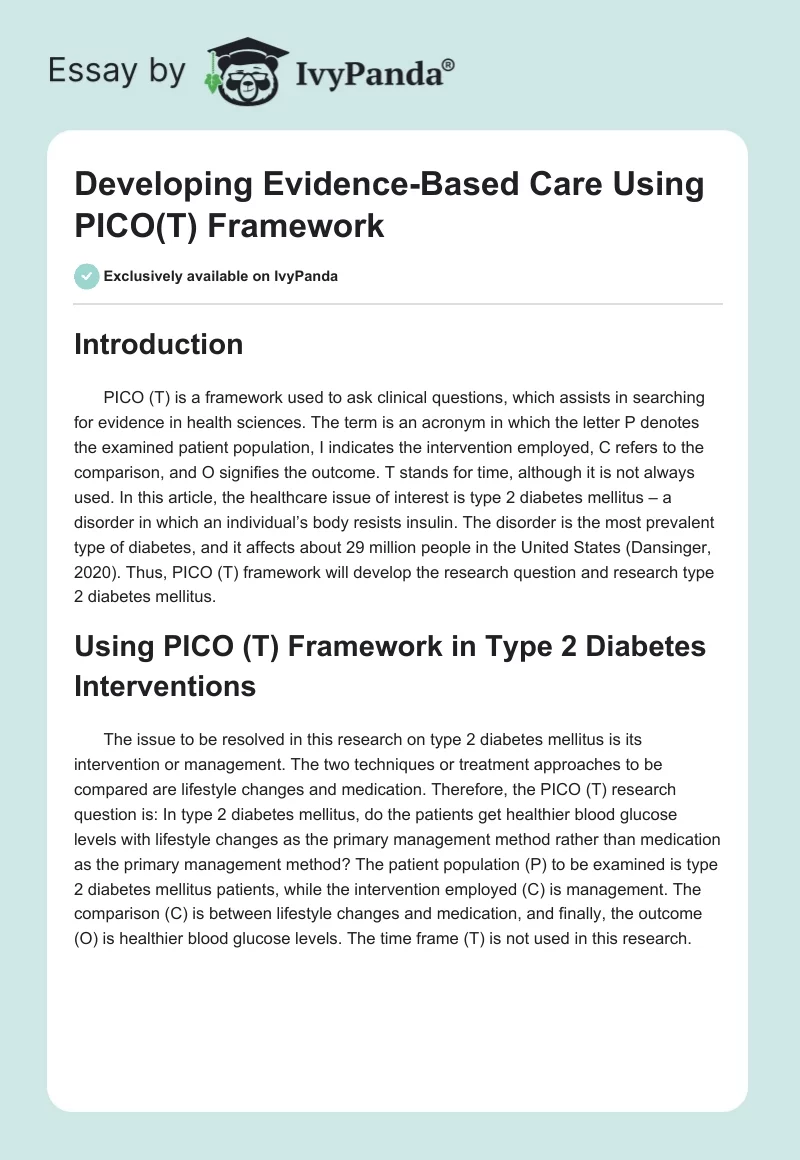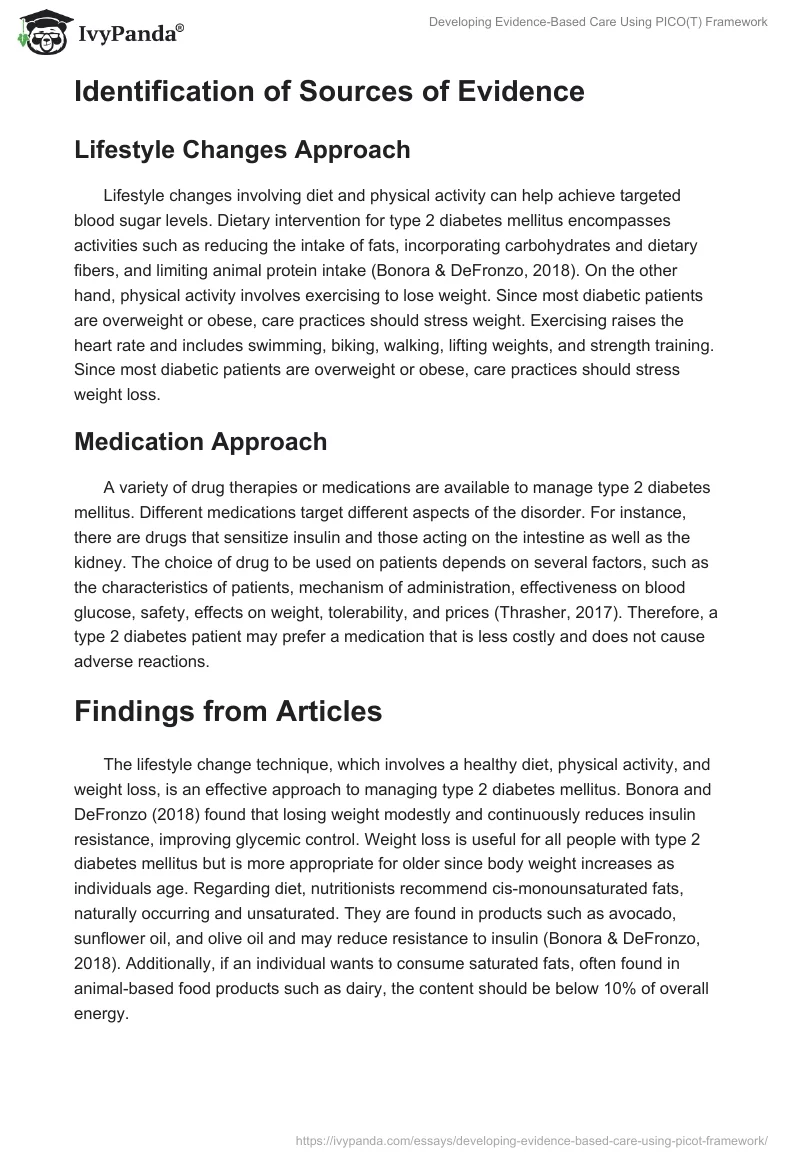Introduction
PICO (T) is a framework used to ask clinical questions, which assists in searching for evidence in health sciences. The term is an acronym in which the letter P denotes the examined patient population, I indicates the intervention employed, C refers to the comparison, and O signifies the outcome. T stands for time, although it is not always used. In this article, the healthcare issue of interest is type 2 diabetes mellitus – a disorder in which an individual’s body resists insulin. The disorder is the most prevalent type of diabetes, and it affects about 29 million people in the United States (Dansinger, 2020). Thus, PICO (T) framework will develop the research question and research type 2 diabetes mellitus.
Using PICO (T) Framework in Type 2 Diabetes Interventions
The issue to be resolved in this research on type 2 diabetes mellitus is its intervention or management. The two techniques or treatment approaches to be compared are lifestyle changes and medication. Therefore, the PICO (T) research question is: In type 2 diabetes mellitus, do the patients get healthier blood glucose levels with lifestyle changes as the primary management method rather than medication as the primary management method? The patient population (P) to be examined is type 2 diabetes mellitus patients, while the intervention employed (C) is management. The comparison (C) is between lifestyle changes and medication, and finally, the outcome (O) is healthier blood glucose levels. The time frame (T) is not used in this research.
Identification of Sources of Evidence
Lifestyle Changes Approach
Lifestyle changes involving diet and physical activity can help achieve targeted blood sugar levels. Dietary intervention for type 2 diabetes mellitus encompasses activities such as reducing the intake of fats, incorporating carbohydrates and dietary fibers, and limiting animal protein intake (Bonora & DeFronzo, 2018). On the other hand, physical activity involves exercising to lose weight. Since most diabetic patients are overweight or obese, care practices should stress weight. Exercising raises the heart rate and includes swimming, biking, walking, lifting weights, and strength training. Since most diabetic patients are overweight or obese, care practices should stress weight loss.
Medication Approach
A variety of drug therapies or medications are available to manage type 2 diabetes mellitus. Different medications target different aspects of the disorder. For instance, there are drugs that sensitize insulin and those acting on the intestine as well as the kidney. The choice of drug to be used on patients depends on several factors, such as the characteristics of patients, mechanism of administration, effectiveness on blood glucose, safety, effects on weight, tolerability, and prices (Thrasher, 2017). Therefore, a type 2 diabetes patient may prefer a medication that is less costly and does not cause adverse reactions.
Findings from Articles
The lifestyle change technique, which involves a healthy diet, physical activity, and weight loss, is an effective approach to managing type 2 diabetes mellitus. Bonora and DeFronzo (2018) found that losing weight modestly and continuously reduces insulin resistance, improving glycemic control. Weight loss is useful for all people with type 2 diabetes mellitus but is more appropriate for older since body weight increases as individuals age. Regarding diet, nutritionists recommend cis-monounsaturated fats, naturally occurring and unsaturated. They are found in products such as avocado, sunflower oil, and olive oil and may reduce resistance to insulin (Bonora & DeFronzo, 2018). Additionally, if an individual wants to consume saturated fats, often found in animal-based food products such as dairy, the content should be below 10% of overall energy.
Still, on a healthy diet, the consumption of carbohydrates helps achieve targeted blood glucose levels. Furthermore, a low glycemic index diet that moderately incorporates carbohydrates and fibers and is primarily based on the intake of legumes, fruits, and vegetables leads to better glycemic control (Bonora & DeFronzo, 2018). There is no evidence that protein intake affects type 2 diabetes mellitus. However, foods full of proteins, such as dairy products and processed meat, also have saturated fats; thus, intake of such protein should be limited.
Physical activity as a mode of therapy is still essential due to its impact on resisting insulin – the fundamental abnormality of type 2 diabetes mellitus. Strength training stimulates insulin-mediated muscle glucose uptake and increases sensitivity to insulin and its action (Bonora & DeFronzo, 2018). Although type 2 diabetes patients are resistant to insulin, they cannot resist the stimulatory effects of physical activity on the stimulation of glucose. The patients remain capable of transporting glucose transporter type 4 (GLUT4) to the sarcolemma due to physical activity.
The medication approach encompasses several drugs that lead to better glycemic control by targeting various aspects of the disorder. In newly-diagnosed cases of type 2 diabetes mellitus, biguanides such as metformin are recommended. These drugs obtain glycemic control by reducing the production of glucose in the liver (Thrasher, 2017). Thiazolidinediones (TZDs) increase patients’ lipocytes, muscle, and liver sensitivity to insulin by stimulating receptors that change various gene transcriptions involved in the metabolism of glucose and lipids. Sulfonylureas obtain optimal glycemic control by aiding the body in producing more insulin. Thrasher (2017) indicates that these medications “stimulate insulin release from the pancreas by binding to the sulfonylurea receptor on the adenosine triphosphate-sensitive potassium channel on the ß-cell membrane” (p. 12). Dipeptidyl Peptidase-4 Inhibitors help patients achieve optimal blood glucose control by increasing the secretion of insulin from the b-cells of the pancreas.
Considering the side effects of most drugs used in the medications approach to type 2 diabetes mellitus management, lifestyle change is a healthier approach and leads to better glycemic control. Thus, lifestyle change should be the primary intervention technique. Resistance to insulin, observed in type 2 diabetes mellitus, is reversible by observing a strict diet and lifestyle, especially when the disorder is detected early (Van Ommen et al., 2018). Type 2 diabetes mellitus involves various processes and parts of the body, making it a systems disease that requires personalized management interventions. However, lifestyle changes and medication are advised to manage the disorder for optimal health results.
Relevance of the Findings
The contribution of Bonora and DeFronzo (2018) to the study of type 2 diabetes mellitus was employed in this research because they extensively analyze the management of the disorder using lifestyle approaches. The authors address healthy eating, weight-loss strategies, and various exercises in detailed chapters. The book discusses how the aforementioned strategies relate to targeted blood sugar levels and provides recommendations to patients. Similarly, the rationale for choosing Thrasher (2017) was that it offered a relevant and detailed discussion of the medication approach to the management of the disorder. The article clearly explains the different types of drugs and the aspects of the disorder they target to obtain glycemic control.
Conclusion
Type 2 diabetes mellitus remains incurable, but it can be managed through lifestyle changes and correct medication. Although lifestyle change is healthier and can lead to better results when correctly employed, the two intervention methods should be utilized together for optimal results. Bonora and DeFronzo (2018) and Thrasher (2017) articles support the aforementioned position. Both approaches have advantages and disadvantages, which patients and nurses must consider when deciding which method to use. However, as proven, the articles are very relevant to the research question.
References
Bonora, E., & DeFronzo, R. A. (Eds.). (2018). Diabetes epidemiology, genetics, pathogenesis, diagnosis, prevention, and treatment (1st ed.). Springer International Publishing.
Dansinger, M. (2020). Type 2 Diabetes. WebMD.
Thrasher, J. (2017). Pharmacologic management of type 2 Diabetes Mellitus: Available therapies. The American Journal of Cardiology, 120(1), 1-15.
Van Ommen, B., Wopereis, S., Van Empelen, P., Van Keulen, H. M., Otten, W., Kasteleyn, M., Molema, J. W., De Hoogh, I. M., Chavannes, N. H., Numans, M. E., Evers, A. W., & Pijl, H. (2018). From Diabetes care to Diabetes cure – The integration of systems biology, ehealth, and behavioral change.Frontiers in Endocrinology, 8(381), 1-12.


